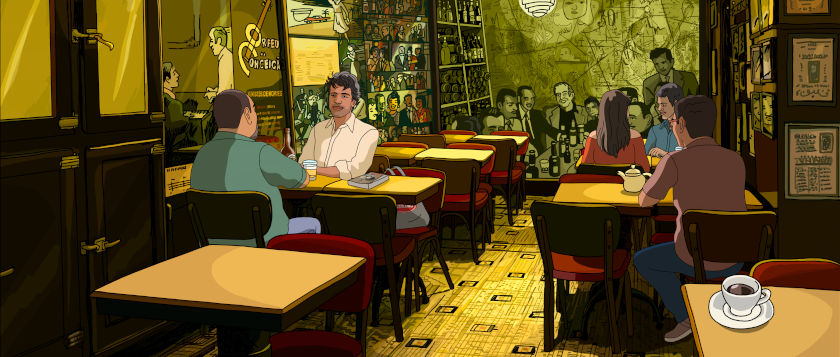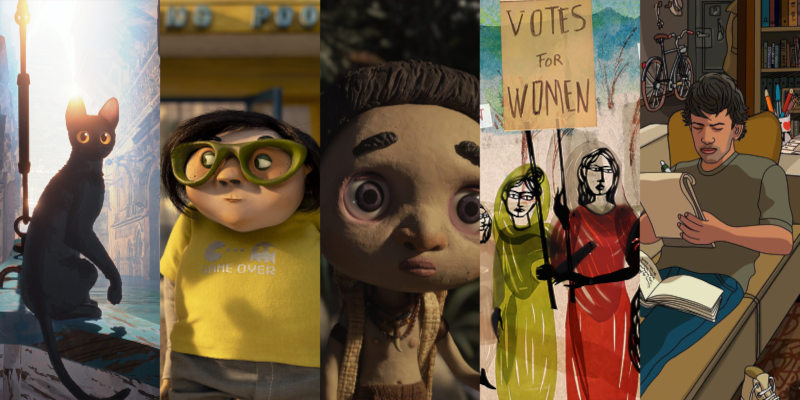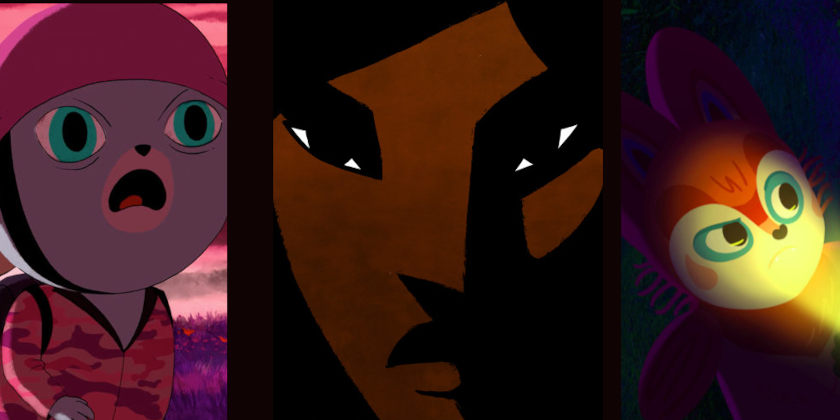'They Shot The Piano Player' Animation Feature: Let's Find Out About It From a Big Team

I had the opportunity to talk with 'They Shot The Piano Player” producers: The Spanishes Cristina Huete at PC and Nano Arrieta at Atlantika Films, Serge Lalou at French Les Films d’Ici, Janneke van de Kerkhof at Dutch company Submarine, and Humberto Santana at Portuguese Animanostra by a meeting online. Unfortunately, Miguel Valladeres at Peruvian Producciones Tondero could not be present.
The subject of this conversation is their animated feature film, directed by Fernando Trueba and Javier Mariscal, the same awarded couple of the Oscar-nominated 'Chico and Rita” (2010). The film premieres at the San Sebastian Film Festival 2023 (22-30 Sep), while its North American rights have been purchased by Sony Pictures Classics.
I was present at the Annecy 2022 presentation of this project when Trueba and Mariscal talked about the 15 years of research and the creative process of this film, which is difficult to define: 'Animation, Documentary, Thriller, Political, Musical,' according to Mariscal, captures the essence of the film. This is a point that all film producers I asked gladly confirmed.
A music journalist from New York sets out on a frantic investigation into the mysterious disappearance of Brazilian pianist Tenório Jr, regular accompanist of Vinicius de Moraes, among others. This animated thriller, moving to the beat of jazz and bossa nova, portrays the days immediately before the Latin American continent was enshrouded by totalitarian regimes - Film Synopsis
There are plenty of interviews with great Bossa Nova’s names from Brazil, where “Rio de Janeiro is a main character of this film,” said Mariscal. However, it also showed Argentina and New York City in 1960. So, there is a color in Rio’s scenes, beautiful pieces of music, thriller, and a green-gray color when the dictatorship memories from Argentina are shown.
Here's this exclusive conversation for the ZF readers below.
ZF: How was it possible to produce an animated feature film divided into five countries?

Serge Lalou, Janneke van de Kerkhof, Humberto Santano, Nano Arrieta
SL: The difficulty was the synchronization of each country with the other and the global artistic supervision to maintain the quality of whatever work was done in each country.
JK: Yeah, that is true. It is generally the lead producer who sets out this technical infrastructure and workflow to ensure that we are all doing the same thing and exporting files in the same way.
CH: Getting financing for an animated film for adults was very difficult. We believed it was essential to have Brazil since it is a tribute to its musicians and history, but this was impossible. We went through many phases, including government changes and pandemics. Spain granted us aid from the Ministry of Culture, TV, Moviestar, ICEC, and TVC, so we had to get it done. Then the other countries came.
HS: For me, it was possible because the animation successfully got support from ICA for minority co-productions. Without this, it was always hard for us to be co-producers in feature films. This participation was the first that we managed that support.
NA: Yeah, with Bolsonaro, all the grants and subsidies for the culture were blocked in Brazil. So, we attended the Cartoon Movie, where we met Submarine and Animanostra. After that was the European structure, we just started to win many grants, so it was step-by-step.
ZF: Working with Trueba and Mariscal is an excellent reason for any producer to want to take part in this project. However, what was the second point that was crucial to embracing 'They Shot The Piano Player'?
SL: It is motivated by political and engaged animation films, and this one had everything. It was an author-driven film based on a solid, political story from a documentary investigation, and entertaining at the end, with powerful artistic choices.
JK: Of course, the theme. In the Netherlands, especially the Latin America topic, the regime of Vidella in Argentina has always been of extreme interest. Nevertheless, their reputation and artistic vision also appealed to us, and I always decide about projects with Bruno (Submarine founder).
HS: I had this opportunity because Portugal entered this production since Brazil could not. The political point of view was exciting. Moreover, that was another point: some parts of the film are spoken in Portuguese, and the music was a factor that pleased me a lot because I grew up listening to all these musicians who had given interviews. Of course, working with Trueba and Mariscal is a privilege.
NA: Fernando wanted to do a documentary. Nevertheless, after all the information, he had the ordinary shooting of the voice-over of the musicians. Some of them are already dead. After the great adventure with Chico and Rita, working with Mariscal, and being close friends, he decided to change and do this animated film.
ZF: What was the most significant challenge during this process?
SL: The most significant challenge was the constant changes, which are different for everybody at every moment. Nevertheless, the strong one was to keep working to keep the solid artistic identity of this film. It is essential since animation can become very industrial, and there is always a conflict between the money process and artistic choices. We have to find the proper equilibrium.
CH: For us, once each producer got their part in their corresponding countries, to fit the coordination between the studios and their schedules was the most challenging. They also ensured that Mariscal’s style was not lost in so many hands. However, the result has been excellent.
JK: I agree with most of what Serge said. For us, to have the planning to work without congestion somewhere (because one studio is waiting for the other studio’s files) and to make that connection in the right way for everyone was a challenge.
HS: The biggest challenge was to keep the animation team enthusiastic about the film because, as mentioned, there were too many changes, technically speaking, in the way of animating.
ZF: The animation was made on how many frames per second in general? Or did it depend on the individual scene?
HS: Each of them had a specific option. There was no rule for it. Carlos [León Sancha], the animation director, obviously wanted more drawings, but we knew it would make post-production more difficult. However, each plan has been working individually.
NA: There were two challenges. Firstly, our European official production is regulated by its regulatory body in each country. So, some rules from the ICA, our regulatory body, sometimes needed to match with, for example, CNC rules. But at the end of the day, it is tough to reach all the deadlines and all the requirements for each institution. On the other side, it was challenging and exciting to match the Spanish way of working with how the French, Dutch, and Portuguese work because there is a strong identity within these countries. So, this type of movie is excellent for this environment, which is fantastic.
ZF: I saw the 2022 presentation in Annecy; Trueba mentioned he did much research about Tenório’s history. Did he have many interviews with Brazilian musicians that we can see in the film?
CH: Fernando did more than 150 hours of interviews and research on the Tenório case. One day, he told me “that he considered him a brother and had to tell his story.” That’s when I realized the film would be made yes or yes. Not all of those I interviewed are there, but a significant majority are telling the story of him and Tenório.
SL: And there is even in the making off of all these interviews.
ZF: During the same presentation, Mariscal said that Rio de Janeiro was the great figure of the film and that Marcelo Quintanilha was responsible for the final version of the characters. Could you elaborate on that?
CH: Marcelo is a great cartoonist, he is also Brazilian and knows all the musicians and his music. He has been fundamental.
NA: Yeah. He was vital in finishing the drawings.
HS: Curiously, you brought up the film graphic line. Some parts of the narrative needed to be very realistic. In that part, Marcelo’s work was quite decisive. However, there was not this all the time. When you watch the film, the colored graphic explodes in freehand. Sometimes, Mariscal said, “No, I don’t want the perfect animation. I don’t want the drawings very well drawn. No, I want color. I want life”.
ZF: What about the aesthetic? How were the different historical periods and places represented in the film?
CH: Fernando has done a great job of documentation. Mariscal loves this, to have much documentation, to then fly with his pencil and colors. The aesthetics of the different times the film takes place were marked and thought out. He calls it clouds. It is looser in line and with less color, which helps to tell what is happening, a tragedy.
HS: There are two approaches in the film for the documentary. In everything that takes place in the actual timeline of the film (the end of the 90s), the line is very realistic and very, very well drawn. However, every time there is a flashback, or we go back to determine that Tenório was alive, the lines are free and much more expressive -and the animation was done more simply.
ZF: The color scheme changes as well. In the past, it was gray and less colorful than in the present period.
HS: Yes. Sometimes, when the music comes on, it flows in colors.
JK: Definitely. However, there are some dark color palettes when it is more political and more threatening, and when it is about the music from that time, it is very colorful. I liked it a lot. The style that was made is very tough and very colored, and it works great in this sort of flashback scene.
NA: It is like going through Mariscal’s world. Playing with these kinds of palettes in Argentina, in the dictatorship are black and white; the Bossa Nova era has its colors. So, it is amazing.
ZF: And as this film was made in animation, what do you think it contributes to telling this story?
SL: As I produce fiction and documentaries, I ask myself why animation is always the question. It was easy to answer in 'Waltz with Bashir' because it was a mental process. Here, the process of mental reconstruction of something is also essential. We also know that Trueba wanted to touch new generations and younger people about this war at the time. And that animation would do it more than a straightforward documentary with interviews about ex-soldiers, etc. That was a good choice since we have music united the visual imagination of Mariscal, where animation fits very well with what the film is talking about.
CH: I could not do it any other way. Furthermore, Trueba’s desire to work with Javier Mariscal again had much influence.
JK: I think it’s nice that animation is used to make different aesthetics for different eras, places, and moods in the film. Moreover, what is nice now is that it still fits all together, even though they are pretty different aesthetics and are drawn from Mariscal, separate from the present time. I also liked how the interviews were treated, so they have rotoscopes. Mariscal is a great artist; drawing and painting are what he does, so animation fits best to make a movie like this.
HS: Well, I think our animation option is obvious. Trueba did his research and filmed all the interviews years ago. The quality of the film right now is not so actual. Moreover, if I did an exercise of imagining this film without animation, the theme would be challenging. Everything is heavy, and it would be a documentary that would not have much public interest. The animation allowed us to take all the material based on the research, recreate it, and put it in a way that would appeal to the general public.
NA: Because you can recreate wherever in animation. You can play with the feelings with the subjective mind of each character. And then you come back to reality with interviews in animation, a new proposal.
ZF: What do you expect from this production on the big screen?
SL: Many people are in theaters for big international festivals, and 'They Shot The Piano Player' is a film made for cinema. It is a visual film made for cinema. It has a significant impact on the screen and also on sound. We need to know what you are giving people now, that they have everything at home when they go to theaters. So, I think this film is a perfect answer, the experience you will have with this film, you cannot have it anywhere else. We respect everything in this movie, like taking the audience to the theaters, which is hard to tell the story to the whole world.
CH: I hope for everything! I am proud that among all of us, we have achieved it.
JK: For me, the musical element works well. It is hard to sit still in your chair with the music. The colors, graphics, and music take you on a never-boring, visually exciting, and engaging journey. As Serge mentioned, it is a film for the big screen.
HS: It will work very well in theaters. I am sure of it.
NA: This is a theatrical movie because of that experience. That was the thing at the very beginning that the director wanted to do.
'They Shot the Piano Player' screens (Special Screening) at the 2023 San Sebastian Film Festival, 22-30 September 2023.



'They Shot the Piano Player' (103', 2023)
Directed by Fernando Treuba and Javier Mariscal | Produced by Cristina Huete, Serge Laloand, Sophie Cabon, Bruno Felix, Janneke van der Kerkhof, Femke Wolling, Humberto Santana | Associate Producer: Arnaud Boulard | Executive Producers Nano Arrieta, Ulrik Frémont, Fabien Westerhof, Juan Carlos Concha | Technical Director: Juan Carlos Concha | Character Design: Marcello Quintanilha | Animation Director: Carlos León Sancha | Editor: Arnau Quiles Pascuai
contributed by: Eliane Gordeeff









